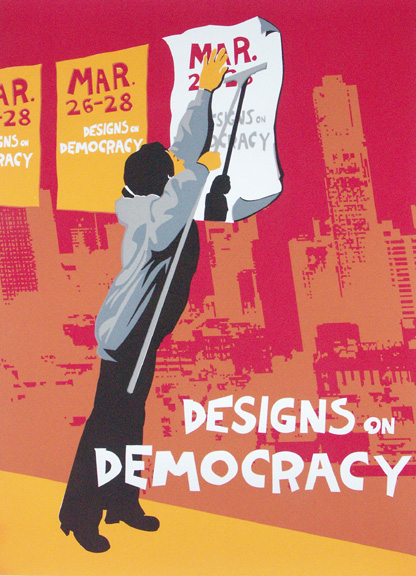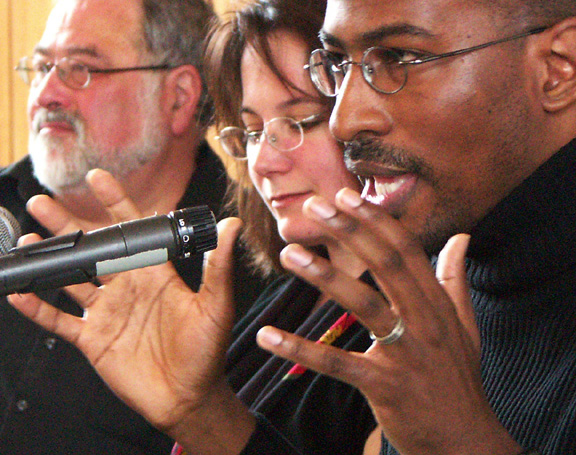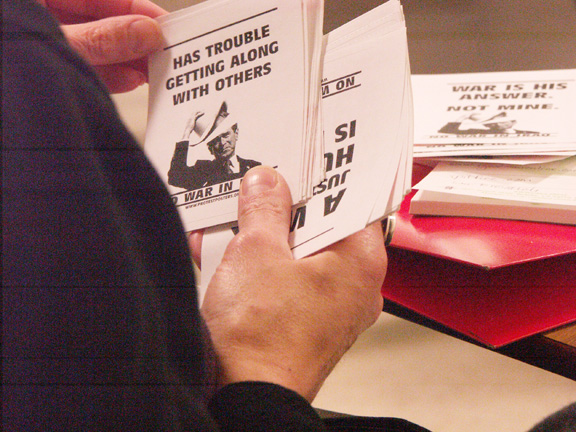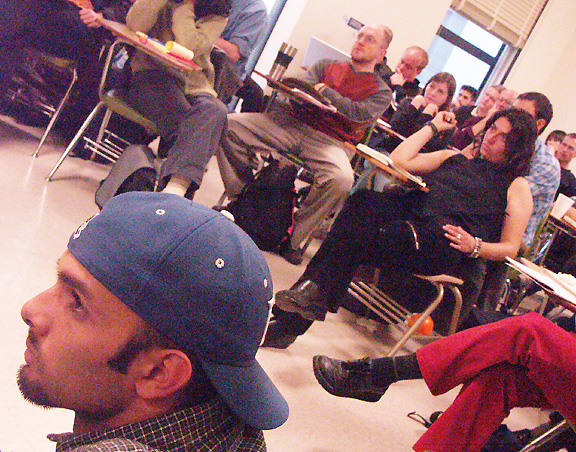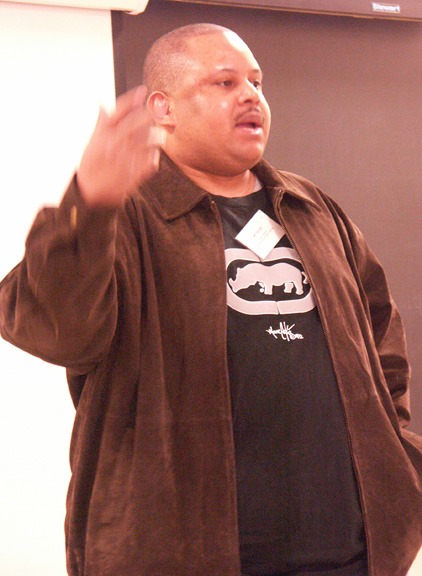From the Open-Publishing Calendar
From the Open-Publishing Newswire
Indybay Feature
Designs on Democracy, a conference on design, advertising, public relations and marketing for social change, took place at the University of California, Berkeley from March 26 to March 28. It was put together by the The Ruckus Society, Change the Game, Tumi's Design and The Design Action Collective. There were eight core organizers and forty volunteers. Three hundred and fifty attended.
This story, in two parts, offers photographs and interviews with eight individuals who presented at the Designs on Democracy conference. Part one, below, features George Lakoff, of the Rockridge Institute, Thea Hillman of Underground Advertising, William Etundi of Counter-Convention.org and Art McGee of Virtual Identity and the Online Policy Institute. The names of the workshops where the people interviewed did their presentations are shown above the photos.
From right to left: Van Jones of the Ella Baker Center for Human Rights, Laura Saponara of Media Alliance and George Lakoff of the Rockridge Institute.
George Lakoff believes the Left should frame its messages with the positive values it represents. He outlined what those values are as he sees them:
"The essential progressive values are empathy, that is caring and connecting with other people, and responsibility, which is acting on that empathy; being responsible for yourself and for others. When you take these and you ask what follows from them, the answer is that when you empathize with people you are protective, whether it is protection of children in your family or worker protection, environmental protection, or consumer protection. If you care about people you want them fulfilled in their lives, you want them to be treated fairly, you want them to have freedom, you want them to have opportunity, which requires prosperity. You need to build a community in order to have that prosperity, to build community you have to have cooperation, and to have cooperation you have to have trust, which requires honesty and open communication. These are the values, they are THE progressive values and every progressive program is there because of these values."
Underground Advertising designed and printed stickers, above, lampooning George W. Bush, which they distributed at demonstrations against the war last year. The story of the stickers was taken up by the San Francisco Chronicle and other media.
Thea Hillman of Underground Advertising spoke about a campaign by the Rainforest Action Network that successfully challenged the policies of Citi Bank:
"RAN, the Rainforest Action Network, ran a multi-year campaign with other environmental organizations designed at pressuring Citi Corp, one of the largest financial institutions in the world, to get them to adopt more environmentally sound practices. RAN thought if they could pressure them to stop financing these harmful practices all around the world, the other banks would hopefully follow suit, and we found that’s what happened.
"We did a combination of a corporate campaign and a grassroots campaign. We ran ads in the New York Times. We also created lots of postcards and stickers. We did direct action, making fake cling ATM screens and fake ATM cards, getting people to cut up their credit cards and send them to the CEO of Citi Bank. Working with grassroots activists really energized the campaign and raised the awareness of the public. The ads worked to pressure Citi Bank and then actually later on worked as a carrot. We said ‘If you will sign this policy and start letting us do environmental audits and eventually adopt a more environmental policy we will run these positive ads about you’ and that was successful. Now you’ve got one of the largest financial institutions in the world adopting the most far-reaching environmental policy in its industry and RAN can go after other organizations. It can say ‘Hey—the leader in your industry is doing this. Can you meet I? Can you beat it?’ That kind of pressure really works in the corporate world because it’s all about competition and they do follow each other.
"We had a successful effort as well with the Home Depot. They’re the largest retailer of lumber in the world and RAN was able to wage a corporate campaign with them and then go after number two, which was Lowe’s, and then number three … We helped with messaging. We helped them narrow their target and talk about how they’re going to reach their target. We helped them to communicate with the public. While they may have had a very good idea of who their target was, we helped them talk to their target. And then talk to the public about what they’re doing and create a groundswell of support for the work that’s happening. We were getting to the consumers."
People attending this workshop included Satya, in the foreground.
William Etundi is a techie and an activist for Counter-Convention.org, a website dedicated to creating opposition to the Republican Convention in New York later this year. He spoke of the issues coming up in his organization:
"What Counter-Convention.org is about is facilitating organizing around the Republican Convention. We have a lot of tools, resources on line that help other organizations, coalitions and community groups to further their protests and communicate with each other in regards to what’s going to happen.
"On the site we have about 100 organizations listed now and that’s growing fast, more are being added each day. The exact number of groups is large, it’s at least 100 and some of those are coalitions that represent dozens of other groups.
"Day to day we do a lot of coding work, a lot of just production work on the site. But there are meetings happening every day—around two meetings a day—of this, that and the other organization. We try to hit up as many of those meetings as we possibly can so that we have a direct accountability to the communities we’re serving, so we’re working with the groups who’re organizing, having them participate in building up the site. We facilitate the different things they need that it makes sense to facilitate on line. That’s the biggest part of it, meeting face to face with other organizers.
"It’s so easy for the press to find us, a lazy google search will bring you to Counter-Convention.org. We get a lot of press, the press is very interested in what’s going to happen around the Republican Convention, they’re very excited and we’re often the easiest point of contact. Because of that, we’re trying to be very conscious, to put all that attention off to the real organizers, the community based groups who don’t get the attention so easily. So we have a very selective list of community people who can speak to the issues—who can speak to the larger movement—as well as speaking on what they’re going to do for the convention. So, whenever a press person calls, whether it’s the New York Times or Nightline or the Village Voice or whoever, we give them our short list of organizers who they can speak to directly and get the fuller story. It is working, you see quotes in the newspapers from people who don’t normally get this kind of attention, and the reason we do that is that we’re not organizers, we’re facilitating the organizers. We’re working on this for six months, while the organizers may be working for ten years."
Art McGee, above, spoke about the importance of e-mail to building an organization, using the example of the Black Radical Congress:
"E-mail is still, even with the proliferation of spam and viruses, the primary on-line organizing tool. It’s still very effective for reaching people in a way that websites and blogs and other electronic tools aren’t. It’s the main thing that people use every day irrespective of what type of computer they happen to use. Everyone usually checks their e-mail first. If you’re trying to reach people e-mail is probably the most effective means of doing it.
"The Black Radical Congress is a national coalition of African-American and African-descended activists, labor organizers, academics and others that came together originally in 1998 in Chicago. I was essentially their communications coordinator. I was doing mostly e-mail and the internet. Essentially we were a very low-budget organization. We got some very interesting feedback, something we didn’t plan on originally, which was that we would get e-mails from people who were teachers in high schools and universities who would tell us they were using the material that we were sending out—material that was intended to be generally educational, but was very radical in its positioning—and that they were using this material in their classrooms. In some cases they would print it out and pass it around to their students, or in other cases they would assign their students to subscribe to our news service in order to read the information.
"It was also something that helped people in rural areas, who had a more left, radical perspective in terms of their politics, but because of were they lived, they often felt isolated, like they were the only person who felt a particular way. The e-mail was able to reach out to them and let them know that there was a large grouping of other Black people in the U.S. and globally who had the same perspectives or similar perspectives as they did.
"To me the most important thing about the internet is not that it's an a technology or a place, but that it's an idea. That the internet is this idea of ubiquitous, many-routed communication, many-to-many communication. The ability of people to communicate directly with each other instead of always having to go through some sort of mediated form of communication, like mainstream newspapers, television or radio. Long after the internet as a technology has disappeared, the internet as an idea will live on."
We are 100% volunteer and depend on your participation to sustain our efforts!
Donate

$220.00 donated
in the past month
Get Involved
If you'd like to help with maintaining or developing the website, contact us.
